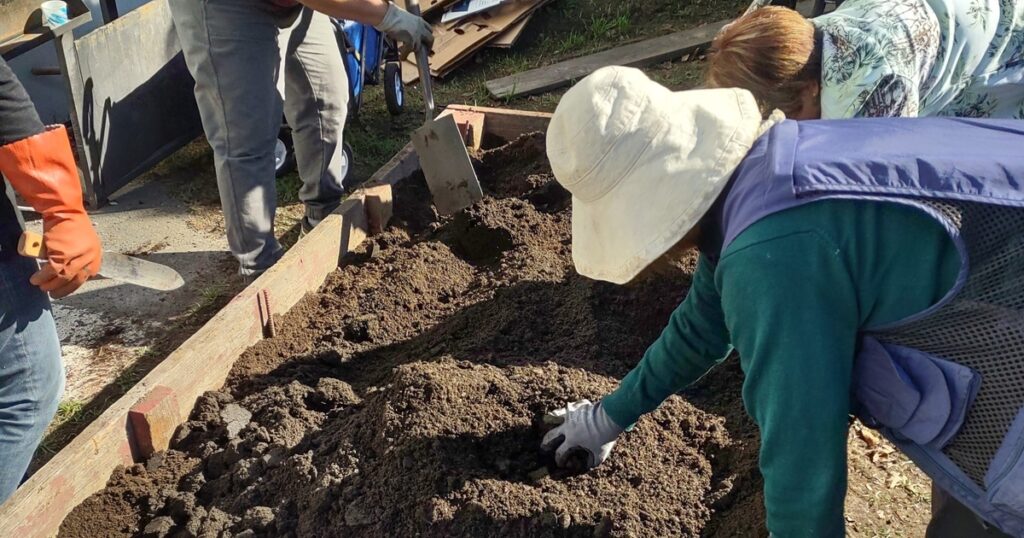Fresh fruits and vegetables are essential to a healthy diet, but if you don't have a refrigerator or a home, it's difficult to keep fresh food on hand.
To improve the health of homeless people, the University of California Collaborative Extension team in Alameda County, CalFresh Healthy Living, is partnering with the South County Homeless Project to grow fresh produce for people staying in emergency housing in Hayward. .
For the past seven years, UCCE Alameda's CalFresh Healthy Living has provided nutrition coaching to residents of the South County Homeless Project as part of building opportunities for self-sufficiency. Classes include Rethinking Drinks, Food Safety, Making Every Money Matter, Healthy Eating, Active Community His workshops, Foraged from the Garden, and more.
The South County Homeless Project facility will house 24 people for up to a year. With the help of CalFresh Healthy Living and the UC Cooperative Extension team, the existing garden was renovated and redesigned. A large outdoor garden at the rear of the property offers residents the opportunity for therapeutic gardening and also provides food for meals.
One resident said, “I love this garden, and when the cooks cook the vegetables, they taste so good. I'm grateful for this garden and the CalFresh Healthy Living team.”
There was once a flower garden in the South County Homeless Project's backyard. After years of neglect, weeds have taken over the garden.
In 2022, CalFresh Healthy Living's UCCE Alameda proposed involving residents in growing food by restoring gardens with edible plants.
“Not only can we continue to engage residents in nutrition education classes, but we can also work together to revitalize neglected gardens,” said MaxFairbee, a nutrition educator with UCCE Alameda's CalFresh Healthy Living team. ” he said.
herbs and vegetables
Residents and staff began work to replace overgrown flower beds with vegetable and herb gardens.
“We worked with South County staff and residents to design, clean, plant, harvest and ultimately incorporate garden food into the kitchen so residents can enjoy the fruits of their labor.” said Fairby.
For gardening expertise and support, Fairby turned to the University of California Master Gardeners of the Alameda County Community Garden Team. CalFresh Healthy Living's UCCE staff continued to offer nutrition classes, while UC Master Gardener volunteers taught residents the basics of gardening.
After heavy rains in April, the group planted 50 saplings. Half of that was donated by the University of California Master Gardeners. They planted two types of lettuce, arugula, four types of tomatoes, zucchini, kale, onions, cucumbers, green beans, Swiss chard, kale, basil, cilantro, tarragon, thyme, parsley, rosemary, oregano, and mint. .
From garden to table
“We harvested lettuce in May and green beans, cucumbers, kale and onions in June,” Fairby said.
Fresh vegetables and herbs were used to make salads, sandwiches, and pasta dishes for residents. Fairby and other educators also used fresh produce in cooking demonstrations and tastings as part of their “Fresh from the Garden” classes.
“We were able to add a lot of the vegetables as garnishes or put them in salads,” said one of the cooks at the South County Homeless Project.
“One of the chefs used zucchini in pasta sauce and it was delicious! I didn't know you could use it that way!'' said one resident.
Selina, a Minami County resident who sampled summer squash and gazpacho made with tomatoes grown in her garden, said, “I was surprised by the deliciousness of raw summer squash and the difference in flavor after cooking.I would definitely like to add more.'' Ta. Zucchini on my plate. ”
assignment
To keep the garden healthy, they faced competition from plant-gnawing snails, slugs, and aphids, as well as soil-digging cats. The water source is more than 60 meters away from the garden, so I run a long hose along the parking lot and across the main road to water the plants, disconnecting the hose after use, and removing it each time to prevent it from being stolen and bringing it indoors. Hide it. .
Another challenge to maintaining the garden is having enough residents and staff to volunteer to help.
“The staff supports the garden, but none of them actually have the time to work in the garden,” Mr Fairby said.
Residents harvest crops, wash them, and store them in the kitchen. Typically, out of her 24 residents, only 4 to 6 of her people are interested in gardening, pulling weeds, and protecting plants from pests, and most are focused on finding new jobs and homes. . South County residents typically move out of temporary housing within a few months.
To provide more consistent garden maintenance, Fairby is recruiting volunteers from other community groups. He also hopes to persuade the county government to install water spigots near the gardens so he can install drip irrigation to water them.
“We want to work with the University of California Master Food Preservers to teach residents how to preserve herbs and vegetables,” Fairby said.
He hopes residents of the South County Homeless Project will be able to continue gardening and grow fresh vegetables in their new homes, enjoying more nutritious meals and better health.
Residents and staff at the South County Homeless Project not only enjoy fresh food, but also the atmosphere of the garden.
“It's so nice to be back there and just sit. It's really peaceful,” said one staff member.
The resident added, “(The garden) relieves me from stress. I love the garden.”
Source: University of California Department of Agriculture and Natural Resources


